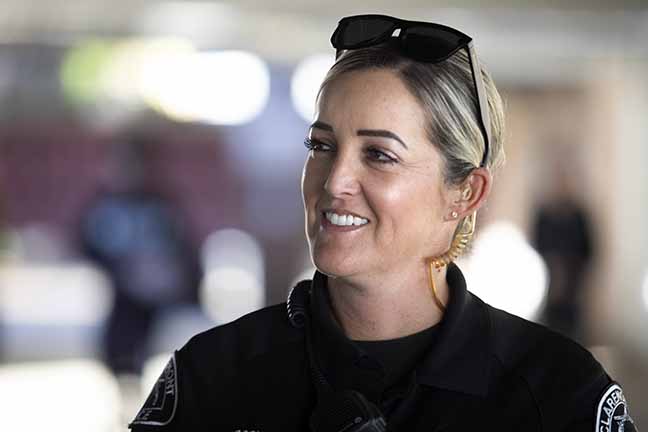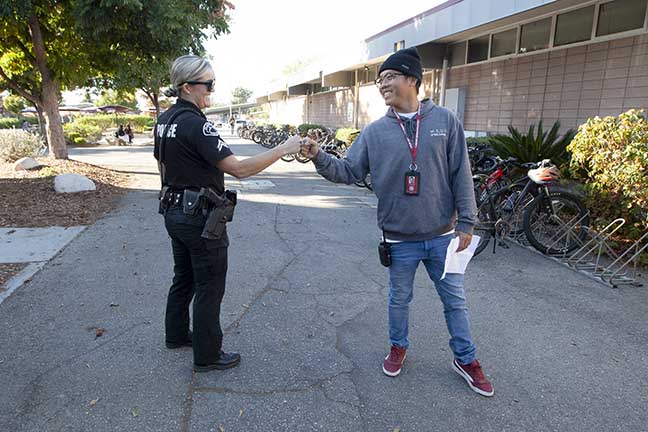Council shifts most of SRO financial burden to CUSD

School resource officer corporal Brittany Sornborger pictured Tuesday at Claremont High School. Courier photo/Steven Felschundneff
by Steven Felschundneff | steven@claremont-courier.com
The yearslong effort to reimagine the role of Claremont’s school resource officer had another setback Tuesday when the Claremont City Council elected to modify an agreement between the city and the Claremont Unified School District that will govern how the program will be administrated going forward.
Following a short, civil debate, the council voted unanimously to approve several crucial changes to the school resource officer memorandum of understanding, which had already been approved by the CUSD Board of Education.
First, the council shortened the term from three years, July 1, 2023 to June 30, 2026, to one year, with the initial term ending on June 30, 2024. The city retained the option of exercising two single-year extensions of the agreement.
Beginning in the second year of the memorandum of understanding the city would no longer commit to fund one half of the school resource officer’s salary and benefits, and the school district would then be responsible for the actual cost of the officer. That expenditure for the district would be capped annually at $200,000 and would only cover the academic year.
During its discussion the council established the actual cost of the program is $153,000 for the school year, September through June, and that the city would cover roughly $67,000 for the summer months when the SRO’s duties revert to those of a regular beat officer.
“In light of the fact that the School District would be responsible for the costs of the SRO program, the City Council also authorized City staff to approve changes to the proposed SRO framework,” city attorney Alisha Patterson wrote in an email on Wednesday.

School resource officer corporal Brittany Sornborger greets proctor Lucky Duong on Tuesday at Claremont High School. Courier photo/Steven Felschundneff
The school resource officer is a uniformed and armed police officer assigned to patrol Claremont’s 10 public school campuses. The cost for the program, which has been operating since 2004, had been split equally by the city and CUSD. Because of the hybrid funding, any action by the council affecting the SRO position must be approved by the CUSD Board of Education.
As such, the CUSD Board will now have to approve the council’s changes to the memorandum of understanding.
Representatives from CUSD, including Assistant Superintendent, Student Services, Kevin Ward, left the council chamber abruptly following the vote. “I have absolutely no comment,” Ward said as he was leaving.
The effort to reimagine the school resource officer began in September 2020 when the Claremont Police Commission formed an ad hoc committee to evaluate the program’s effectiveness and come up with alternate approaches to school safety.
The ad hoc committee’s eventual recommendation was influenced by research that showed SRO programs do not make schools safer and that Black and Hispanic students often feel threatened by having uniformed, armed officers on campus.
Conversely, some parents have testified that the presence of a police officer on campus makes them feel that their children are protected, particularly with the growing frequency of school shootings in the U.S.
A school resource officer working group was impaneled in 2021 by then Mayor Jennifer Stark after the council voted to end the current SRO program. During a series of meetings held February through August 2022, the working group considering a number of versions of the SRO program before finalizing the one approved by the council in September 2022.
The council’s SRO framework recommended the school resource officer, corporal Brittany Sornborger, focus her patrols on the perimeter of Claremont campuses, “to be aware of suspicious activity that may be occurring near schools.” She would be present on school campuses when requested by CUSD officials for emergencies or calls for service. She would also be present for security at large events such as assemblies and high school graduations.
In November 2022 CUSD’s Board of Education proposed several modifications to the framework approved by the council “to avoid redundancies and to clarify Claremont Unified School District’s (CUSD) expectations of the SRO position,” according to a staff report from City Manager Adam Pirrie.
Key changes by the Board of Education included continuing to allow Sornborger to patrol campus sites during school hours, eliminating the rule that kept her at schools’ perimeters unless responding to calls for service.
The Board of Education also struck down portions of the agreement that required the district to make more mental health resources available to students, arguing that the district is already responsible for mental health care and the SRO agreement was not the right place for that language.
Finally, the board objected to the creation of a school safety committee because it could duplicate efforts already being addressed by its equity advisory council.
Pirrie’s report further explains that CUSD officials have continued outreach efforts with students during the previous school year, and the beginning of the current year, in order to learn more about what makes some students uncomfortable about having the SRO on campus.
“Additionally, members of the City Council, the BOE, and City/CUSD staff met on October 30, 2023 to discuss the framework that was approved by the BOE (Attachment C) in November 2022, and agreed that the framework was reflective of the feedback that was provided by CUSD students,” Pirrie wrote.
The meeting was attended by CUSD Superintendent Jim Elsasser, Ward, Mayor Ed Reece, Mayor pro tem Sal Medina, City Manager Adam Pirrie, Assistant to the City Manager Katie Wand, CUSD Board of Education President Kathy Archer, and board Vice President Bob Fass.
“During the October 30th meeting, the CUSD team provided information about their outreach initiatives to CUSD students related to the SRO program,” Mayor Reece wrote in an email. “They also revealed some of the work that has been or will soon be carried out based on the feedback acquired from the students. These measures aim to foster better relationships between the SRO and students as well as enhance awareness about the SRO program. Furthermore, the meeting emphasized that establishing a Memorandum of Understanding (MOU) is essential for setting the parameters of the program.
“Consequently, to create a document that outlines standards and ensures accountability for the program, we suggested that incorporating feedback from students and staff into the MOU and submitting it to the City Council was necessary. The City is responsible for providing public safety to our community, including students, and by providing the school district with the ability to have SRO services, it fulfills this essential obligation.”
Since its inception the SRO program has lacked a guiding document, but city staff, including Patterson, recommended that even if the city asks CUSD officials to pay for the program entirely, a memorandum of understanding would be a very good idea since Sornborger is a city employee.
“Having an MOU in place will clearly define the roll of the SRO moving forward which we anticipate to be beneficial to the SRO, the city, the school district, and to students,” Wand said during her presentation to the council.
Nearby cities Pomona and Covina have MOUs with their school districts even though the schools pay for the SRO entirely, according to Wand.
The memorandum of understanding passed by the council Tuesday will have to be placed on a future Board of Education agenda, but the exact timeline is unknown.
Claremont High proctor Pablo Jimenez stopped to chat with Sornborger as she strolled the campus on Tuesday. “We need the backup sometimes,” Jimenez said, adding he hoped the council will vote to keep Sornborger on campus.








0 Comments